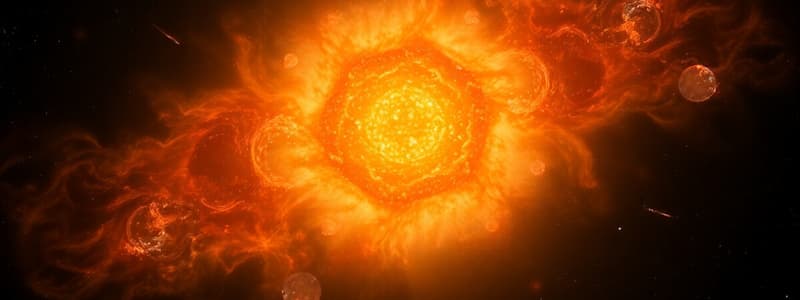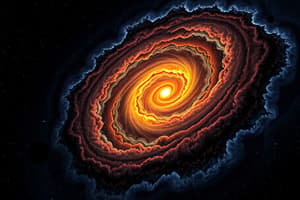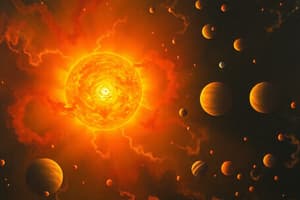Podcast
Questions and Answers
What process began as the solar nebula continued to accumulate material?
What process began as the solar nebula continued to accumulate material?
- Dissipation of energy
- Condensation of gases (correct)
- Expansion of the nebula
- Formation of meteoroids
At what distance was the condensation process most effective according to the solar nebula theory?
At what distance was the condensation process most effective according to the solar nebula theory?
- In the outer regions
- At varying distances
- Near the core (correct)
- At the highest temperatures
Which materials are considered stable at the highest temperatures during the solar nebula's evolution?
Which materials are considered stable at the highest temperatures during the solar nebula's evolution?
- Iron and nickel
- Gases and vapors
- Meteoroids and comets
- Silicates and oxides (correct)
What results from the condensation process described for the solar nebula?
What results from the condensation process described for the solar nebula?
Which process ended when the temperature decreased in the solar nebula?
Which process ended when the temperature decreased in the solar nebula?
Which elements predominantly contributed to the solid materials condensing in the solar nebula?
Which elements predominantly contributed to the solid materials condensing in the solar nebula?
What does the condensation process ultimately affect in the solar nebula's temperature profile?
What does the condensation process ultimately affect in the solar nebula's temperature profile?
How did the release of energy influence the solar nebula's evolution?
How did the release of energy influence the solar nebula's evolution?
What primarily composes asteroids?
What primarily composes asteroids?
Which statement is true regarding the orbit of planets in the solar system?
Which statement is true regarding the orbit of planets in the solar system?
What differentiates comets from asteroids?
What differentiates comets from asteroids?
Which of the following best describes the composition of the outer planets?
Which of the following best describes the composition of the outer planets?
What is a key characteristic of the orbits of inner planets compared to outer planets?
What is a key characteristic of the orbits of inner planets compared to outer planets?
What phenomenon leads to the evolution of a planet's atmosphere?
What phenomenon leads to the evolution of a planet's atmosphere?
What role do meteorites play in understanding the history of the solar system?
What role do meteorites play in understanding the history of the solar system?
Which of the following correctly describes the characteristics of Uranus and Neptune?
Which of the following correctly describes the characteristics of Uranus and Neptune?
Flashcards
Planet
Planet
A celestial body that orbits a star. Planets are large enough to have cleared their neighborhood of other objects and have enough gravity to be round.
Asteroids
Asteroids
Objects that orbit a star and are much smaller than planets.
Comets
Comets
Icy bodies that orbit the Sun in highly elliptical paths, often leaving a trail of gas and dust.
Ecliptic Plane
Ecliptic Plane
Signup and view all the flashcards
Rotation
Rotation
Signup and view all the flashcards
Revolution
Revolution
Signup and view all the flashcards
Kuiper Belt
Kuiper Belt
Signup and view all the flashcards
Oort Cloud
Oort Cloud
Signup and view all the flashcards
Solar Nebula
Solar Nebula
Signup and view all the flashcards
Condensation of the Solar Nebula
Condensation of the Solar Nebula
Signup and view all the flashcards
Formation of Planets by Condensation
Formation of Planets by Condensation
Signup and view all the flashcards
Condensation of Metals
Condensation of Metals
Signup and view all the flashcards
Condensation of Silicates
Condensation of Silicates
Signup and view all the flashcards
Condensation of Ices
Condensation of Ices
Signup and view all the flashcards
Importance of Condensation in Planet Formation
Importance of Condensation in Planet Formation
Signup and view all the flashcards
Chemical Differentiation of Planets
Chemical Differentiation of Planets
Signup and view all the flashcards
Study Notes
The Solar Nebula
- The solar nebula was a rotating disk of gas and dust that formed the Sun and planets.
- Abundances of isotopes found in meteorites suggest the solar nebula existed 4.6 billion years ago.
- The nebula formed from a cloud of interstellar gas and dust and grew denser and hotter due to its own gravity.
- The center of the nebula became the Sun.
- Temperatures were hottest at the center, decreasing further out.
- Different materials condensed at different temperatures in different regions creating different planetary compositions.
Condensation and Chemical Compositions of Planets
- The temperature in the solar system varied with distance from the Sun.
- Different materials condensed at various temperatures.
- At Earth's distance, only metals, oxides, and silicates condensed.
- At greater distances, ices (like water) condensed.
- The chemical makeup of the different planets reflects the condensation process that occurred in their respective regions.
Model Requirements for the Solar System
- Each planetary system model must explain nine fundamental properties of the solar system.
- Planets are relatively isolated in space but progressively further from the central Sun.
- Planetary orbits are nearly circular and nearly in the same plane.
- Planets rotate in the same direction as the Sun's rotation.
- Moons generally orbit their planets in the same direction as the planets orbit the Sun.
Studying That Suits You
Use AI to generate personalized quizzes and flashcards to suit your learning preferences.




